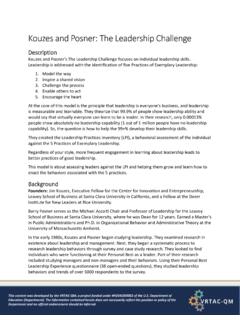Transcription of Total Quality Management (TQM)
1 This content was developed by the VRTAC-QM, a project funded under #H264J200002 of the Department of Education (Department). The information contained herein does not necessarily reflect the position or policy of the Department and no official endorsement should be inferred. Total Quality Management (TQM) Description The Total Quality Management (TQM) system focuses on the customer with long-term success measured through customer satisfaction. TQM is designed to be a dynamic process where all staff in the organization are involved in continual improvement of processes, products, services, and organizational culture to enhance Quality .
2 It uses strategy, data, and effective communications to integrate the Quality principles into the culture and activities of the organization. Many of the concepts that originated with TQM are present in other modern Quality Management systems, the successors to TQM. The eight principles of Total Quality Management are as follows: : The customer ultimately determines the level of Quality . No matterwhat an organization does to foster Quality -- employees, integrating Quality into thedesign process, or upgrading computers or software -- the customer determineswhether the efforts were employee involvement: All employees work toward common goals.
3 To gain totalemployee commitment, fear must be driven from the workplace, employees must feelempowered, and Management must provide the proper environment. Self-managedwork teams are one form of empowerment. High-performance work systems integratecontinuous improvement efforts with normal business : A fundamental part of TQM is a focus on process thinking. A processis a series of steps that take inputs from suppliers (internal or external) and transformsthem into outputs that are delivered to customers (internal or external).
4 The stepsrequired to carry out the process are defined, and performance measures arecontinuously monitored in order to detect unexpected system: Although an organization may consist of many different functionalspecialties often organized into vertically structured departments, it is the horizontalprocesses interconnecting these functions that are the focus of Micro-processes add up to larger processes, and all processes aggregate into thebusiness processes required for defining and implementing strategy. Everyonemust understand the vision, mission, and guiding principles as well as the qualitypolicies, objectives, and critical processes of the organization.
5 Businessperformance must be monitored and communicated integrated business system may be modeled after the Baldrige Award criteriaand/or incorporate the ISO 9000 standards. Every organization has a uniquework culture, and it is virtually impossible to achieve excellence in its productsand services unless a good Quality culture has been fostered. Thus, an integratedsystem connects business improvement elements in an attempt to continuallyimprove and exceed the expectations of customers, employees, and otherstakeholders.
6 This content was developed by the VRTAC-QM, a project funded under #H264J200002 of the Department of Education (Department). The information contained herein does not necessarily reflect the position or policy of the Department and no official endorsement should be inferred. 5. Strategic and systematic approach: A critical part of the Management of Quality is the strategic and systematic approach to achieving an organization s vision, mission, and goals. This process, called strategic planning or strategic Management , includes the formulation of a strategic plan that integrates Quality as a core component.
7 6. Continual improvement: A core aspect of TQM is continual process improvement. Continual improvement drives an organization to be both analytical and creative in finding ways to become more competitive and more effective at meeting stakeholder expectations. 7. Fact-based decision-making: In order to know how well an organization is performing, data on performance measures are necessary. TQM requires that an organization continually collect and analyze data in order to improve decision making accuracy, achieve consensus, and project future outcomes based on past history.
8 8. Communications: During times of organizational change, as well as part of day-to-day operation, effective communications is crucial in maintaining morale and in motivating employees at all levels. Communications involve strategies, method, and timeliness. These principles are considered so essential to TQM that many organizations define them, in some format, as a set of core values. The methods for implementing this approach come from the teachings of Philip B. Crosby, W. Edwards Deming, Armand V. Feigenbaum, Kaoru Ishikawa, and Joseph M.
9 Juran. Background The history of Total Quality Management (TQM) began initially as a term coined by the Naval Air Systems Command to describe its Japanese-style Management approach to Quality improvement. In the 1920s, some of the first seeds of Quality Management were planted as the principles of scientific Management and swept through industry. Businesses clearly separated the processes of planning and carrying out the plan, and union opposition arose as workers were deprived of a voice in the conditions and functions of their work.
10 The Hawthorne experiments in the late 1920s showed how worker productivity could be impacted by participation in Management . In the 1930s, Walter Shewhart developed the methods for statistical analysis and control of Quality which informed future the work of Dr. Edwards Deming and Joseph M. Juran who are considered the founders of TQM. In the 1940s, during World War II, Quality became more statistical in nature. Statistical sampling techniques were used to evaluate Quality , and Quality control charts were used to monitor the production process.


